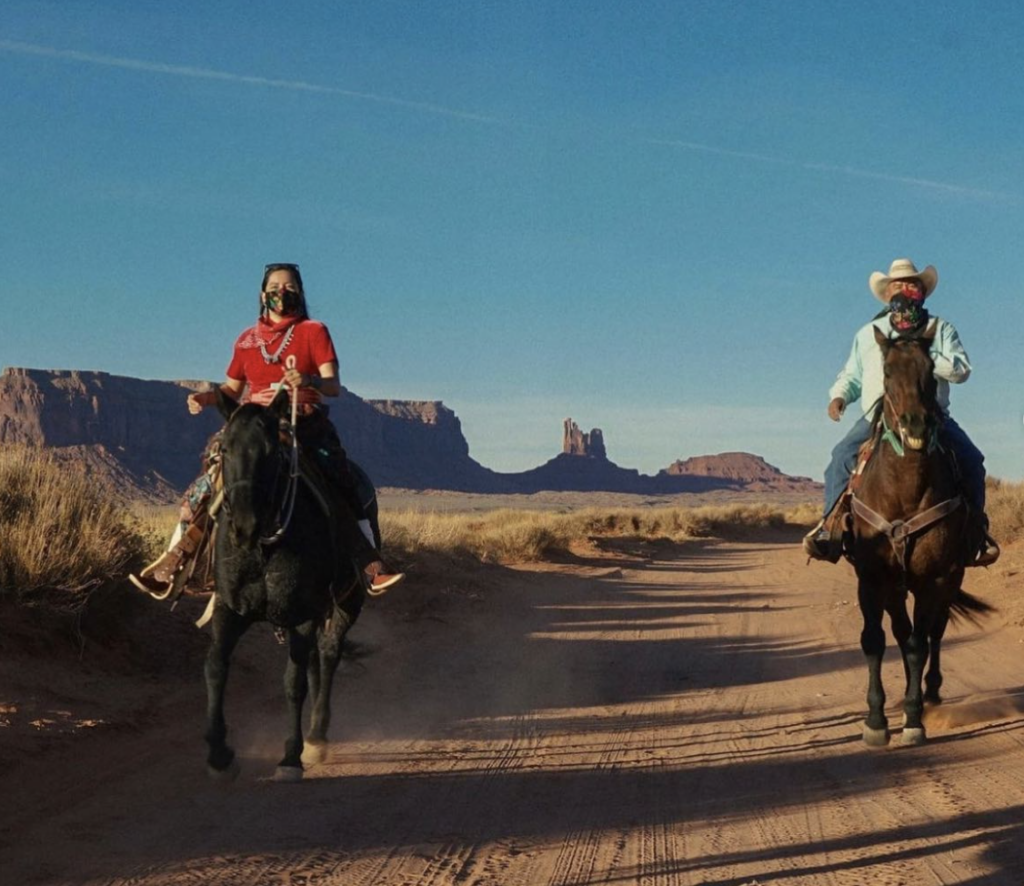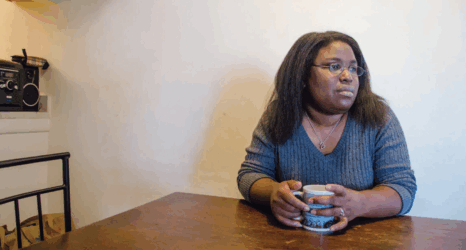
Allie Young’s activism started on the set of an Adam Sandler movie. An extra on The Ridiculous Six, she joined a group of background actors in walking out on the film due to the inaccurate and hypersexual portrayal of Native women in the film. “Since then I’ve been very outspoken about positive Native representation and the need for that, in combating invisibility and erasure of native peoples across the media,” Young said.
A member of the Navajo Nation, Young has continued to advocate for Indigenous communities. In 2020, she founded Protect the Sacred in response to the challenges Navajo Nation faced during the COVID-19 pandemic.
“It was really a grassroots movement and mutual aid efforts, where we weren’t seeing the funding and resources from the federal government,” said Young. The organization also worked with Navajo youth to come up with public health messaging for the community, encouraging them “to step up and be modern-day monster slayers”—a term from traditional Native creation stories. Young also emphasized the importance of protecting the elders of the community: “They’re the ones that we were really fighting for and protecting because our elders hold that ancestral knowledge that all of us are still learning.”

During the 2020 election, Young led “Ride to the Polls,” leading Indigenous residents on a trail ride to cast their votes early in Arizona. Tribal communities across the country face unique challenges in accessing the polls, including the sheer distance to travel to get to a polling location. Indigenous communities did not formally have the right to vote everywhere in the United States until 1962, after Utah removed its legal barriers. “Even after we got the right to vote, there were still tactics that were used to make it hard for us to make our voices heard and to be counted,” said Young.
Though the pandemic was difficult for the entire country, it struck Native communities especially hard. Navajo Nation, roughly the size of West Virginia, has just 12 health facilities, and most are clinics rather than hospitals. When there was a shortage of ICU beds across the nation, this problem was exacerbated in Navajo Nation—the reservation has just 13 ICU beds and 28 ventilators.
In addition, phrases spouted by the CDC as easy ways to fight COVID spread, such as washing your hands with soap and water for 20 seconds, are not always easily accessible in tribal communities: According to Young, 30 percent of the nation lacks running water, and 40 percent does not have electricity.
FEMA set up alternate healthcare sites outdoors in Navajo Nation to offset the COVID surge during the peak of the pandemic, but some were unable to run due to staffing issues. Many elders do not trust government programs because of past trauma, something Young says was not accounted for: “I don’t think there was thought put into how that would look to elders who have experienced trauma in these nation-to-nation relationships.”
In response, Protect the Sacred partnered with Community Organized Relief Effort (CORE) to add extra space and beds near the homestead for members of the community suffering from COVID, allowing them to remain on their own land and next to their families.
For Young, the pandemic highlighted how the government has repeatedly let Native communities down. “The government has upheld their end of the treaties, where we’re guaranteed healthcare and education,” Young said. “But the pandemic reveals that it’s been chronically, severely underfunded and under-resourced.”
Where the U.S. government has been falling short, Navajo Nation has been stepping up. Navajo Nation officials are distributing personal protective equipment such as masks and hand sanitizer in Shiprock, N.M. Officials are looking to use drone technology to deliver food and medicine to community members in remote areas.
In addition, the community has high vaccination rates, with 72 percent of eligible residents and more than 87 percent of elders vaccinated. Navajo Nation is currently experiencing high case counts due to an Omicron surge, but overall rates of death have been low since vaccination became widespread. “I hope that people can see that a highly vaccinated region can save lives and push back on COVID-19,” said Navajo Nation President Jonathan Nez.
104 new cases, 45,952 recoveries, and no deaths related to COVID-19 pic.twitter.com/Sf4N1teCr9
— Navajo Nation President Jonathan Nez (@NNPrezNez) January 31, 2022
President Nez recently signed an executive order requiring all government workers in the Nation to get a booster shot and redefined “fully vaccinated” to mean two vaccine shots plus a booster. Protect the Sacred has also been working to incentivize people to get vaccinated, hosting vaccine clinics with entertainment and food trucks.
In November, the Biden administration released a statement emphasizing their dedication to supporting Native communities, including working to improve vaccination rates among Native Americans, devoting $32 billion to tribal communities, and restoring protections to Native lands. Biden also restored the White House Council on Native American Affairs to promote the voices of Native Americans in government, something Young stressed the importance of.
Young was recently invited by the Biden administration’s social team to participate in their social media series to highlight the needs of tribal communities and the ways in which the administration is working with tribal leaders. “For far too long, Indigenous voices have been left out of federal policymaking and elections,” Young said in a recent video. “So it was really important to be able to come together with the Biden-Harris administration to work together to strengthen democratic participation across our communities.”
President Biden and Vice President Harris took historic action to invest in Tribal communities in their first year in office. Allie met with Vice President Harris to talk about the important work of strengthening voting rights for Tribal communities. pic.twitter.com/m6eTZAISZr
— The White House (@WhiteHouse) January 21, 2022
While there have been great strides in representation over the past year, including Deb Haaland becoming Secretary of the Interior, “we have so many leaders that should be at the table in these decision-making processes,” said Young. “We have those solutions, because we face those barriers every day.”
Up next:





